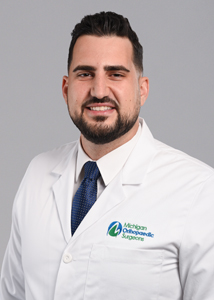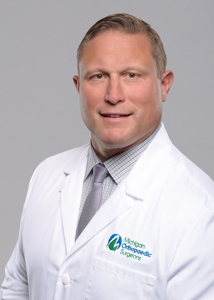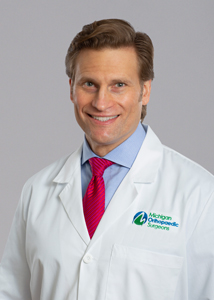Our experts are armed to offer extensive, effective care.
If you’re experiencing elbow pain, we can ease it. Elbow injuries are commonly caused by overuse in jobs, sports or activities that involve repetitive motion. But elbows are also susceptible to dislocations, fractures and even arthritic conditions.
Conditions
Tennis Elbow
Cause
Studies show tennis elbow is the result of damage to one muscle: the extensor carpi radialis brevis (ECRB). (This muscle helps stabilize the wrist when the elbow is straight.) If the ECRB is weakened through overuse, it can cause micro tears in the tendon, near where it attaches to the lateral epicondyle, which can lead to pain and inflammation.
Who’s Likely to Get It
While most people who suffer from tennis elbow are athletes, anyone who overuses their ECRB muscle can get this condition. For example, painters, plumbers and carpenters are prone to it. And cooks, butchers and auto workers are more likely to be diagnosed than the average person. Additionally, tennis elbow is most common among people between the ages of 30 and 50, but it can happen to anyone, of any age.
Symptoms
Symptoms of tennis elbow develop gradually. Typically, there’s a mild pain that worsens over time. Other signs include:
- Pain or burning on the outer part of the elbow
- Weak grip strength
- Symptoms that worsen with forearm activity
Most cases affect the dominant arm, but it is possible to have this condition in the other.
Treatments
When it comes to tennis elbow, 80 to 95% of patients have success with nonsurgical treatment, including:
- Rest: Take a break from the activity that causes the pain or discomfort.
- Physical therapy: Do specific exercises to improve the strength of your forearm muscle(s). A therapist could also perform ice massage or other muscle-stimulating techniques to help heal the affected area.
- Brace: Use a brace on the back of your elbow to help rest certain muscles.
- Extracorporeal shock wave therapy: This procedure sends shock waves through your elbow that promote your body’s natural healing process. It’s known to be experimental, but positive results have been recorded.
- Equipment check: If you participate in a racket sport, make sure your equipment is the proper fit. For example, using a stiffer racket and/or looser-strung racket can reduce stress on your forearm muscles.
If symptoms do not improve after six to 12 months of nonsurgical treatment, your doctor may recommend a surgical treatment. There are several factors that contribute to the type of surgical procedure, but most will involve removing damaged muscle and reattaching healthy muscle to the bone. Details of the surgery vary and depend on health, your personal goals, and level of your injury. Options include:
- Open surgery: This is the most common surgical procedure to correct tennis elbow. It involves making the incision above the elbow.
- Arthroscopic surgery: This procedure reverses symptoms using miniature instruments and small incisions.
Cubital Tunnel Syndrome
Cause
Cubital tunnel syndrome, also known as ulnar nerve entrapment, is when the ulnar nerve becomes compressed and irritated. (The ulnar nerve is one of the three main nerves in your arm. It travels from your neck down to your hand and can be constricted in many places, including in the collarbone or at the wrist.) This can be caused by:
- Bending your elbow often or for long periods of time
- Leaning on your elbow/putting pressure on it
- Fluid buildup that creates swelling, which puts pressure on the ulnar nerve
Symptoms
Cubital tunnel syndrome can result in an aching pain inside the elbow, but many symptoms occur in the hand, including:
- Numbness and tingling in the ring finger or little fingers (more common when the elbow is bent)
- A weaker grip or trouble with finger coordination (in severe cases)
Treatments
For nonsurgical support, doctors may recommend:
- Medication: If the symptoms started recently, anti-inflammatory medication, such as ibuprofen, could help reduce the swelling.
- Braces/splints: Doctors may recommend braces or splints to keep your elbow straight at night.
- Nerve gliding: Some doctors believe performing exercises that help the nerve slide can improve symptoms. These exercises can prevent stiffness in both the arm and wrist.
Surgery is only recommended if nonsurgical treatment was not effective, the ulnar nerve is VERY compressed, or if nerve compression has resulted in muscle weakness or damage. Procedures include:
- Cubital tunnel release: This procedure cuts and divides the ligament roof of the cubital tunnel. As a result of the increased space, pressure is reduced on the nerve.
- Ulnar nerve anterior transportation: In some cases, the ulnar nerve is moved from behind the elbow to the front. This move prevents the nerve from getting caught and stretching in the bony ridge of the medial epicondyle when the elbow is bent.
- Medial epicondylectomy: To reduce pressure on the nerve, doctors remove part of the medial epicondyle. Similar to the anterior transportation procedure, this helps prevent the nerve from getting caught in the bony ridge when stretching around the elbow.
Distal Bicep Tendon Rupture
Cause
Bicep tears near the elbow are uncommon. They’re often caused by sudden injury and result in greater arm weakness (when compared to bicep injuries near the shoulder).
Types
There are two types of tears: partial and complete.
- Partial tears: When you damage soft tissues, but the tendon is not completely torn
- Complete tears: When you tear the tendon completely from the attachment point on the bone
Most are complete tears. And unfortunately, once torn, the bicep tendon at elbow will not grow back or heal. (However, other muscles make it possible to bend your elbow without the tendon.)
Symptoms
Injuries to the bicep tendon at the elbow normally happen as a result of the elbow being forced straight against some form of resistance. A common example is lifting a heavy box. Say you pick up a box and it’s heavier than you expected. Your bicep muscles and tendons strain, trying to keep lifting, but the weight forces your arm straight. The stress on your bicep and tendons could tear them away from the bone.
Normally, there is a pop at the elbow when this condition occurs. Pain will be severe initially, but it will reduce over a week. Other symptoms include:
- Swelling in the front of the elbow
- Visible bruising in the elbow and forearm
- Weakness in the bending of the elbow
- Weakness in supination, or the twisting of the forearm
- A bulge in the upper part of the arm, created by a recoiled bicep muscle
- A gap in the front of the elbow, created by the missing tendon
Treatments
To regain full function and arm strength, surgery is required. Nonsurgical treatment may be recommended if the patient is older or not active, or if the injury occurs in a non-dominant arm, where you can tolerate less arm function.
Nonsurgical procedures focus on relieving pain, while maintaining as much arm function as possible. Treatment options include:
- Rest: Avoid heavy lifting or activities in which the arms are lifted over the head. A doctor may also recommend using a sling.
- Non-steroidal anti-inflammatory medication: Ibuprofen and naproxen help reduce pain and swelling.
- Physical therapy: Once your pain reduces, your doctor may recommend exercises to strengthen the muscles around the bicep and tendons. This will help you regain function in your arm.
Surgical procedures should be performed within two to three weeks of the injury. After the third week, the muscles begin to shorten and scar… decreasing the possibility of regaining function. There are several procedures to reattach the distal bicep tendon to the forearm bone. Some doctors perform a procedure involving one incision in front of the elbow, while others perform a procedure involving an incision in the front and back of the elbow. One common surgical procedure attaches the tendon with stitches through holes drilled in the radius bone. Another procedure attaches the tendon to the bone using small metal implants.
Olecranon Bursitis
Cause
Elbow bursitis occurs in the olecranon bursa, a thin and fluid-filled sac that is located on the bony tip of the elbow. The olecranon bursa is normally flat, but if it becomes irritated or inflamed, more fluid will accumulate in the bursa. This results in bursitis.
Elbow bursitis occurs for several reasons:
- Trauma: A hard hit on the top of your elbow can result in the bursa producing excess fluid and swelling.
- Prolonged pressure: Leaning on the elbow over a long period of time, on a hard surface, may cause the bursa to swell. (This type of bursa will develop over several months. Hard surfaces, like table tops or hard floors, make certain professions more vulnerable to these types of bursae.)
- Infections: An injury on the elbow that breaks the skin can infect the bursa. An infected bursa can produce fluid, redness, swelling and pain.
- Medical conditions: Certain medical conditions, such as rheumatoid arthritis and gout, have been associated with elbow bursitis.
Symptoms
The first sign is swelling, which can be difficult to notice, as the tip of the elbow has loose skin. Then, as the swelling increases, the bursa will stretch, resulting in pain. (Pain is often worse with direct pressure, and it may increase to the point that it restricts elbow movement.)
Treatments
If it’s suspected that bursitis is infected, your doctor may aspirate the bursa with a needle. (This involves removing the fluid, which will reduce symptoms and give the doctor a sample to be sent and checked for bacteria.) Doctors may also prescribe antibiotics while they test the sample, to ensure the symptoms do not get worse.
If the bursitis is NOT infected, other nonsurgical treatment options include:
- Elbow pads: Cushion the elbow
- Activity change: Avoid activities that put pressure on or aggravate the elbow bursitis
- Medications: Ibuprofen and other anti-inflammatory drugs can reduce swelling and relieve symptoms
If an infected bursa does not improve with antibiotics or fluid removal, surgery to remove the entire bursa may be necessary. Once removed, the bursa usually grows back over several months – fully functional. If the bursa is not infected, surgery may still be required, if other nonsurgical treatments did not improve the symptoms. The bursa will be removed, while not disturbing other muscles.
Osteochondritis Dissecans
Cause
Osteochondritis Dissecans, or OCD, is a condition that occurs in the joints, mostly in children and adolescents. It presents itself when a small piece of bone begins to separate, due to lack of blood flow. As a result, the bone and cartilage surrounding it begin to crack and loosen. The most common joints affected by this condition are the knees, ankles and elbows. (OCD usually affects one joint, but it can affect multiple joints in children.)
Symptoms
Pain and swelling of the joints are the most common symptoms. More advanced OCD may result in joints locking or catching.
Treatments
Most cases of OCD in children and teens will heal over time, especially when they have a lot of growing to do. Rest, and avoiding vigorous sports until symptoms resolve, will relieve pain and swelling.
If symptoms do not improve after a reasonable amount of time, your doctor may recommend using crutches or splinting/casting the affected joint for a period. Most children will see improvements in two to four months.
Your doctor will recommend surgery if:
- Nonsurgical treatment does not improve the condition
- The lesion is detached from the surrounding bone and cartilage, moving around within the joint
- The lesion is large, greater than one centimeter in diameter, especially in older teens
A procedure will depend on the individual and the condition, but options include:
- Drilling into the lesion to create a new pathway for blood vessels to nourish the affected area
- Holding the lesion in place with internal fixation, such as screws or pins
- Replacing the damaged area with a new piece of bone and cartilage
Elbow Fracture
Cause
An elbow fracture, also known as an olecranon fracture, is a break in the bony tip of the elbow. (This is part of the ulna, which is one of three bones that form the elbow.) These types of fractures are common. And while they can be isolated, they can also be part of a more complicated elbow injury.
Olecranon fractures are often the result of:
- Falling directly on the elbow
- A direct blow to the elbow from something hard, like a baseball bat or car door
- Falling on an outstretched arm with the elbow held tightly to brace against the fall
Symptoms
An olecranon fracture comes with sudden and intense pain, and it can prevent you from moving your elbow. Other symptoms include:
- Swelling over the back of the elbow
- Bruising around the elbow, which can extend up the arm toward the shoulder or down the arm in the forearm
- Tenderness to the touch
- Numbness in one or more fingers
- Pain when moving the elbow or forearm
- Feeling of instability in the elbow, as if your elbow will pop out
Treatments
Not all olecranon fractures require surgery. If you visit an emergency room, a doctor will likely put you in a splint to keep the elbow in position and apply ice to reduce the swelling/pain. You may also be given medication to help reduce it.
If the pieces of bone aren’t out of place, your fracture can be treated with a splint. This will keep the elbow in place during the healing process, although your doctor will need to do frequent X-rays to ensure the pieces of bones do not shift. This process typically takes six weeks, and if pieces do shift, surgery may be necessary.
Surgery is also required for an olecranon fracture if the bones have moved out of place or pieces of bones have punctured the skin. It usually involves putting the pieces back in the appropriate position and preventing them from shifting. Specific procedures include:
- Open reduction and internal fixation: This is the most common. The pieces of bone are repositioned in the appropriate position and held together with screws, pins and wire.
- Bone graft: If some of the bone is lost in the injury, the fracture may leave gaps that need to be filled. Bone graft can be taken from donors or other parts of your body (usually the hip).
- Removal of the fracture fragments: If the bone fragments are too small to repair, they are sometimes removed. After this is done, the tendon is reattached to the remaining portion of the ulna.
Elbow Dislocation
Cause
While uncommon, elbow dislocation can occur when the joint and surface of an elbow are separated. Dislocations can be complete or partial, and they’re usually the result of some form of trauma. They typically occur when a person falls on an outstretched hand.
Types
There are three types of elbow dislocation:
- A simple dislocation does not have a major bone injury.
- A complex dislocation can have severe bone and ligament injuries.
- A severe dislocation occurs when blood vessels and nerves that travel across the elbow are damaged. When this occurs, there’s a risk of losing the arm.
Symptoms
A complete dislocation is very painful and obvious. The arm will look deformed and twisted near the elbow. However, partial dislocations are harder to detect. As a result of only partially dislocating, the bones can relocate and appear fairly normal. The elbow will move somewhat well, but there will be pain. Bruising will appear on the inside and outside of the elbow.
Treatments
Elbow dislocations require an emergency injury. The goal of immediate treatment is to realign the elbow. The long-term goal is to regain function.
Elbow alignment can be restored in a hospital emergency departent. A doctor will give sedatives and pain medications, then perform a procedure called a reduction maneuver.
Simple dislocations can be treated by keeping the elbow immobile in a sling for one to three weeks, followed by early motion exercises. In a complex dislocation, surgery may be necessary to align bones and repair ligaments. The elbow will be placed in an external hinge to protect it from dislocating again. If blood vessels and nerves were damaged in the injury, additional surgery may be required.
Ulnar Collateral Ligament Tear (UCL) / Tommy Johns
Cause
Elbow injuries in “throwers” are often the result of overuse and repetitive high stress. These injuries range from minor damage and inflammation to a complete tear.
Who’s Likely to Get It
For “throwers,” the ulnar collateral ligament is the most commonly injured. Pain will usually reduce when the athlete stops throwing. (This injury is uncommon in anyone not throwing repeatedly.)
Symptoms
Those who damage their UCL will have pain on the inside of the elbow and noticeable decrease in throwing ability. Like many other throwing-related conditions, pain will initially begin during or after throwing. As a result, the velocity at which one throws will decrease, if not the entire ability to throw.
Treatments
Most throwing injury treatments begin with rest. However, you can also try:
- Physical therapy: Specific exercises can help restore flexibility and strength.
- Change of position: Evaluating your throwing mechanics can help put your body in the correct position to limit stress on your elbow.
- Anti-inflammatory medication: Ibuprofen and naproxen reduce pain and swelling.
If symptoms do not reduce with nonsurgical treatment, or if the athlete wishes to continue throwing, surgery may be required. Surgical procedures include:
- Arthroscopy: Bone spurs on the olecranon, loose fragments of bone or cartilage within the elbow joint will be removed.
- UCL reconstruction: Those with unstable or torn UCL ligaments who do not see results with nonsurgical treatment are eligible for surgical ligament reconstruction. During this procedure, doctors replace the torn ligament with tissue graft. In most cases, the ligament can be repaired with one of your own tendons. This procedure is commonly known as Tommy John Surgery, named after the first major league baseball pitcher to undergo the procedure.
Treatments
Experts at Michigan Orthopaedic Surgeons offer the following treatment options:
- Autograft (UCL Tear)
- Bicep Tendon Rupture Surgery
- Bursitis/Impingement Surgery
- Closed Reduction
- Elbow Arthritis Surgery
- Elbow Arthroscopy
- Elbow Surgery
- Non-Operative Bicep Tendon Rupture Treatment
- Olecranon Fracture Surgery
- Radial Head Fracture Surgery
- Tennis Elbow – Lateral Epicondylitis Surgery
- Throwing Injury Surgery
Doctors





Peter Donaldson MD
Elbow, Foot and Ankle, Hip, Knee, Nonsurgical Orthopaedics, Shoulder, Sports Medicine












